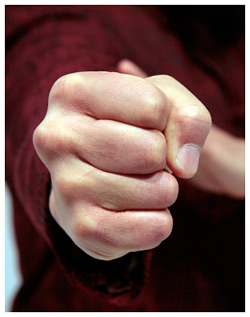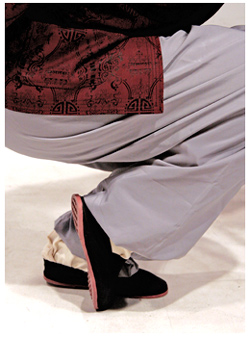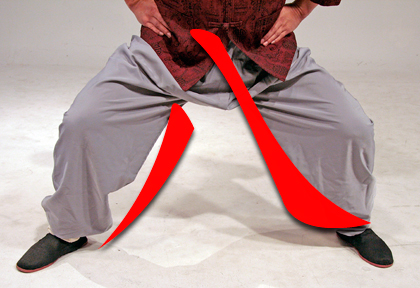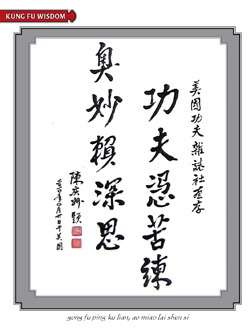Back when I was a head instructor, I eavesdropped on lessons given by the junior instructors to make sure they were getting it right. Any school would be remiss without some monitoring, and being an instructor - junior or senior - is a learning process. I overheard a junior instructor answer a question about why a particular punch was called a "sun" fist. He quickly quipped, "Because it's going to hurt like the sun when I hit you with it." That made no sense at all. Nevertheless, the aggressive response intimidated the student into accepting the answer for a short while.
 The term sun fist, or yat gee kuen in Cantonese, is used in Bak Sil Lum. Bak Sil Lum, or Northern Shaolin, is a long fist style from Guangdong (Canton as it used be called back in the old days.) It refers to the orientation of the fist in a straight punch. In a sun fist, the palm faces inward, the fingers are curled horizontally and the thumb is on top. That?s in contrast to what we call a "flat" fist where the palm faces downward, the fingers are curled vertically and the thumb faces inward. Flat fist was used in that Bak Sil Lum school for lack of a better term. In truth, only the sun fist was distinguished by a name, while all other fists were just called "fist." In Bak Sil Lum, there's a rule of thumb (pun intended) about when to use a sun fist versus a flat fist. A sun fist is used for straight punches that are shoulder height or above. A flat fist is used for straight punches that are shoulder height or below. If you extend your arm in a straight punch and have someone push against it, comparing the different fist orientations, you can feel the difference. Sun fist punches feel more stable above the shoulder while flat fist punches feel better for targets below.
The term sun fist, or yat gee kuen in Cantonese, is used in Bak Sil Lum. Bak Sil Lum, or Northern Shaolin, is a long fist style from Guangdong (Canton as it used be called back in the old days.) It refers to the orientation of the fist in a straight punch. In a sun fist, the palm faces inward, the fingers are curled horizontally and the thumb is on top. That?s in contrast to what we call a "flat" fist where the palm faces downward, the fingers are curled vertically and the thumb faces inward. Flat fist was used in that Bak Sil Lum school for lack of a better term. In truth, only the sun fist was distinguished by a name, while all other fists were just called "fist." In Bak Sil Lum, there's a rule of thumb (pun intended) about when to use a sun fist versus a flat fist. A sun fist is used for straight punches that are shoulder height or above. A flat fist is used for straight punches that are shoulder height or below. If you extend your arm in a straight punch and have someone push against it, comparing the different fist orientations, you can feel the difference. Sun fist punches feel more stable above the shoulder while flat fist punches feel better for targets below.
Later I heard that same student ask the same question of the same instructor. This time, the junior instructor was prepared. He replied that if you imagined shoulder level as the horizon, the sun fist referred to fist techniques "in the sky" or above the shoulder line. It was a very imaginative answer and helped that student remember when to use which fist. It was also a complete fabrication, albeit a very creative one.
Sun fist is a literal translation. The "sun" in sun fist refers to the Chinese character for sun: yat in Cantonese (or ri in Mandarin 曰 ). The character for yat is a tall rectangle, split by a horizontal line. This character is based on a pictogram. Sun pictograms are culturally universal: a perfect circle. To distinguish them from a circle, the sun pictogram is generally given a central dot. Western astrology still uses this pictogram to symbolize the sun. When Chinese calligraphy was developed, it converted the circle into strokes because it is nearly impossible to make a perfect circle using an oriental calligraphy brush. In Japan, just painting a circle is an art form in itself. The circle is called the enso and it is an expression of Zen.
 Using the shape of a character to describe something is a common construct of written language. We do this in English with words like A-frame, O-ring, T-shirt and U-turn. With over 45,000 Chinese characters, there are ample examples of character shapes being used to describe things. Any construct of Chinese culture spills over into Chinese martial arts. Without a basic understanding of this, misunderstandings like that junior instructor's sun fist will always arise.
Using the shape of a character to describe something is a common construct of written language. We do this in English with words like A-frame, O-ring, T-shirt and U-turn. With over 45,000 Chinese characters, there are ample examples of character shapes being used to describe things. Any construct of Chinese culture spills over into Chinese martial arts. Without a basic understanding of this, misunderstandings like that junior instructor's sun fist will always arise.
On the most fundamental level of kung fu, character-shaped prefixes permeate how stances are described. Dingbu is an example. Ding is a surname, but it is shaped like a T (丁). This stance is often (and appropriately) translated as T-stance. Alternatively, it is translated as nail stance because a nail looks like a T in profile. The T shape refers to the position of the lead foot and leg in this stance.
Character-shaped prefixes are usually followed by the character for character, which is gee in Cantonese and zi in Mandarin. That's the gee in yat gee kuen. Dingbu is an exception to this rule (if there's one rule about Chinese culture, it's that there are always exceptions). A common example of another character-shaped prefix lies in Wing Chun and Hung Gar. In Cantonese, it is called yee gee kim yeung ma (literally "two-character clamp goat horse" or er zi qian yang ma in Mandarin 二字拑阳马). In this case, it refers to the shape of the character for two, which is a short line on top of a longer line 二. This character is seen in the position of the toes and heels. In the yee gee kim yeung ma, the toes are pointed inward and the heels outward, just like the character.

The character for eight is also comprised of two strokes. However, instead of being horizontal like in the character for two, they are diagonal and point inward (八). This is used derogatorily as slang for when someone has a weak horse stance and their toes point outward. In kung fu, the feet are parallel in horse stance. When the toes point outward, it is easier to sweep the leg. Some forms of qigong allow the toes to point outward so they align better with the knee. But these are health-cultivating forms of qigong where the practitioner is in no danger of a leg sweep. Ironically, the shape of both of the characters for two and eight are the same: narrow at the top and wide at the bottom. However, they are used to describe two very different stance principles.
This is a classic example on how colloquial Chinese martial arts can be. Unlike most martial arts, the Chinese schools descend mostly from a folk tradition instead of a military one. Consequently, kung fu was not universally formalized, standardized or codified. There have been attempts, but none have succeeded. This is just as well. The true depth of Chinese martial arts lies buried beneath its vast diversity.

On a more complex level, character-shaped prefixes are used to describe the patterns of footwork in forms much like dance steps. A common example is a Hung Gar standard form called kung gee fook fu kuen (literally "work-character tame tiger fist" 工字馴虎拳 ). The footwork of this form is in a pattern like the character for kung, which is like an H on its side 工. There are even cases of characters being used to describe particular patterns of sword strokes, although this has more mystical implications than actual combat applications.
This relationship between calligraphy and martial arts runs deep within Chinese culture. The sword and the pen symbolize two polarities of Chinese culture: martial and scholar. Emperors are often categorized as being either warrior-like or scholarly. Just as a rightful emperor must balance yin and yang, a martial artist must harmonize the scholar and the warrior. Consequently, many Chinese martial arts masters practice calligraphy as a form of aesthetic cross training. There are so many who practice both disciplines that the closing page of Kung Fu Tai Chi magazine is reserved for calligraphy art by famous martial arts masters. That section is titled "Kung Fu Wisdom" and has been running since 2004.
 Does this mean that everyone who studies Chinese martial arts must also study Chinese? Not necessarily. It all depends on how deeply you want to penetrate the arts. Anyone can appreciate art casually. This is no different than visiting a museum without really knowing much about the exhibits. There is nothing wrong with enjoying the arts at this level. Casual art aficionados contribute grass-roots support for the arts that is critical to its perpetuation. You don't even need to know what a piece of calligraphy says to appreciate its graphic aesthetic. In fact, some famous calligraphy pieces are so artsy that they are almost illegible, even to native readers. This is reminiscent of urban graffiti in America. Graffiti is a study in dynamics of the spray paint can. Chinese calligraphy is similar, except it?s all about the brush stroke.
Does this mean that everyone who studies Chinese martial arts must also study Chinese? Not necessarily. It all depends on how deeply you want to penetrate the arts. Anyone can appreciate art casually. This is no different than visiting a museum without really knowing much about the exhibits. There is nothing wrong with enjoying the arts at this level. Casual art aficionados contribute grass-roots support for the arts that is critical to its perpetuation. You don't even need to know what a piece of calligraphy says to appreciate its graphic aesthetic. In fact, some famous calligraphy pieces are so artsy that they are almost illegible, even to native readers. This is reminiscent of urban graffiti in America. Graffiti is a study in dynamics of the spray paint can. Chinese calligraphy is similar, except it?s all about the brush stroke.
The practice of martial arts has always been an abstraction. Everyone can practice to kill and not be killed, but there is no authentic substitute for the real thing. Traditional constructs were in place to protect the practitioner. Red herring movements were added to confuse rival spies from stealing techniques. Even today, showy moves were added to heighten the spectacle for public performances. Over the centuries, Chinese martial arts have gathered so much cultural baggage that much of it has become abstract and inapplicable. This often dilutes transmission to modern students. When you're trying to teach someone how to throw a simple straight punch, you don't want to get bogged down with a lesson in Chinese calligraphy.
While admiring calligraphy - or even graffiti - in an abstract way is fine, you will understand it more if you know what it says. The more you know about the background of any art, be it martial or calligraphic, the deeper your appreciation grows. This applies to the practice of martial arts on both a superficial and profound level. The student who can read a little Cantonese is not confused by terms like yat gee kuen or yee gee kim yeung ma.
Like so many aspects of Chinese culture, character-shaped prefixes in the martial arts are like a Chinese box. Open one and you?ll discover another inside. A small idea starts small, but if pursued diligently, it gets progressively more complex until it explodes in your mind and opens up a new world view. This is the power of art. Given the combative nature of the martial arts, it is easy to overlook it as an art form. For many practitioners, the basic skills of self defense upstage the artistry. It is a woeful oversight, as the martial arts can express so much depth when framed in the proper context. But frankly, art is challenging. Basic self defense is much simpler. Nevertheless, the word "art" appears in "martial arts" twice. I confess this is coincidental, but the fact remains that there is deep artistry to the martial arts that goes unacknowledged in Western pop culture.
| Sun (yat in Cantonese, ri in Mandarin 曰) |
| Character (gee in Cantonese, zi in Mandarin 字) |
| Ding (jang in Cantonese 丁) |
| Two (yee in Cantonese, er in Mandarin 二) |
| Eight (baat in Cantonese, ba in Mandarin 八) |
| Work (kung in Cantonese, gong in Mandarin 工) |
About
Gene Ching :
![]() Written by Gene Ching for KUNGFUMAGAZINE.COM
Written by Gene Ching for KUNGFUMAGAZINE.COM
![]() Print Friendly Version of This Article
Print Friendly Version of This Article
















